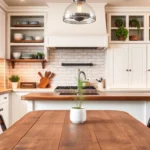
The Japandi style seamlessly marries Japanese minimalism with Scandinavian functionality, creating interiors that are both soothing and sophisticated.
In this article, we will delve into 25 stunning Japandi kitchen ideas that encapsulate the essence of minimalist elegance. Each idea showcases clean lines, earthy tones, and a harmonious balance between aesthetics and practicality. Prepare to be inspired by these beautiful spaces that elevate the art of cooking and entertaining to new heights.
1. Warm Wood Accents

Incorporate warm wood tones into your Japandi kitchen for a cozy yet contemporary feel. Whether it’s through cabinetry, shelving, or accent pieces, natural wood brings warmth and texture to minimalist spaces.
Consider using blonde woods for cabinets and darker woods for countertops or flooring to create a dynamic contrast. Pair these with sleek metal fixtures to maintain the minimalist aesthetic. This blend of materials results in a kitchen that is not only functional but also visually appealing, creating a welcoming atmosphere for family and friends.
2. Neutral Color Palette

A neutral color palette is essential in achieving the Japandi aesthetic. Soft whites, muted grays, and earthy tones create a calming environment that feels both spacious and inviting.
Consider painting your walls in a warm ivory and pairing them with darker cabinetry in charcoal or deep brown. Accents in soft beige or taupe can be used in textiles like curtains and chair cushions. This layering of neutral shades not only enhances the minimalist vibe but also allows for easy coordination with natural materials and decor items.
3. Open Shelving Displays

Open shelving is a hallmark of Japandi kitchens, allowing for both organization and aesthetic appeal. It encourages the display of beautiful dishware, plants, and decorative items, emphasizing simplicity and functionality.
By choosing open shelves made from natural wood or metal, you can create an airy feel that enhances the kitchen’s spaciousness. Arrange your favorite dishes and accessories in a thoughtful way, grouping items by color or style to maintain a cohesive look that still feels personal and inviting.
4. Minimalist Lighting Fixtures

Lighting is a crucial element in Japandi kitchens, where minimalist fixtures can make a significant impact. Opt for simple yet stylish pendant lights or wall sconces that complement the clean lines of your kitchen.
Choose lighting in materials like matte black, brushed brass, or natural wood to enhance the minimalist aesthetic. Warm-toned bulbs can create a cozy atmosphere, making your kitchen inviting for cooking or entertaining. The right lighting not only serves a functional purpose but also adds to the overall design allure.
5. Functional Layouts

The layout of a Japandi kitchen should prioritize functionality without sacrificing style. A well-thought-out design allows for smooth workflow and easy access to essential items.
Consider incorporating a kitchen island for additional prep space and storage, while keeping pathways clear and accessible. Integrate hidden storage solutions, such as pull-out drawers and built-in appliances, to maintain a clean and uncluttered look that embodies the minimalist aesthetic. Functionality and beauty go hand in hand in these elegantly designed spaces.
6. Natural Textures

Incorporating natural textures helps to soften the sleek lines often associated with minimalist design. From wooden cabinets to stone countertops, these elements add warmth and depth to a Japandi kitchen.
Consider using textured materials like polished concrete, rough-hewn wood, and matte ceramics to create a tactile experience. Layering different textures can enhance the visual interest of the space, making it feel both sophisticated and cozy. This combination promotes a connection with nature, which is a core principle of Japandi interiors.
7. Greenery and Natural Elements

Integrating greenery into your kitchen design enhances the Japandi aesthetic while bringing life and vibrancy to the space. Plants not only purify the air but also create a sense of calm and relaxation.
Choose low-maintenance plants like succulents, herbs, or snake plants, which can thrive in kitchen environments. Use beautiful ceramic pots or minimalist planters to maintain the clean lines of the design. Position plants on windowsills, shelves, or countertops to create a harmonious balance between nature and functionality.
8. Elegant Minimalist Appliances

In a Japandi kitchen, the choice of appliances significantly contributes to the overall aesthetic. Opt for elegant, minimalist appliances that blend seamlessly with the cabinetry and overall design.
Look for appliances in muted colors or stainless steel finishes that maintain the kitchen’s clean lines. Built-in options can further enhance the uncluttered look, making the kitchen feel more spacious. The key is to select appliances that are both functional and stylish, embodying the essence of minimalist elegance.
9. Subtle Decorative Elements

While Japandi kitchens embrace minimalism, they also allow for subtle decorative elements that infuse personality and charm into the space. Thoughtfully chosen decor can enhance the kitchen’s aesthetic without overwhelming it.
Consider incorporating a few well-placed art pieces, decorative bowls, or stylish cookbooks that reflect your personal style. The goal is to keep decor minimal yet meaningful, ensuring each piece contributes to the overall harmony of the kitchen.
10. Smart Storage Solutions

Effective storage solutions are vital in a Japandi kitchen, allowing for an organized and clutter-free environment. Utilize smart storage options that blend seamlessly with the design while maximizing space.
Incorporate deep drawers, pull-out shelves, and hidden compartments to keep kitchen essentials out of sight. This approach not only enhances functionality but also maintains the minimalist aesthetic, ensuring that every item has a designated place. A well-organized kitchen promotes a sense of calm and order.
11. Textured Backsplashes

A textured backsplash can add depth and interest to a Japandi kitchen while maintaining the minimalist ethos. Consider using materials like natural stone, wood, or textured tiles that complement the overall design.
A subtle backsplash can act as a focal point without overwhelming the space, enhancing the kitchen’s elegance. Choose colors and textures that harmonize with your cabinetry and countertops, allowing for a cohesive look that remains true to the Japandi style.
12. Integrated Dining Spaces

Incorporating an integrated dining space within your kitchen enhances both functionality and social interaction. A seamless transition between cooking and dining areas embodies the Japandi philosophy of simplicity and connection.
Consider a dining table that matches the kitchen cabinetry or an island with seating to create a harmonious flow. Use minimalist dining chairs that are both stylish and comfortable, ensuring that the space feels inviting for family meals or gatherings with friends.
13. Earthy Color Accents

Incorporating earthy color accents can enhance the natural feel of a Japandi kitchen. Rich browns, muted greens, and deep blues can add warmth and character to the otherwise neutral palette.
Use these colors in textiles, decor items, or even small appliances to create a cohesive design. Earthy accents not only add visual interest but also connect the space to nature, reflecting the core principles of Japandi interiors while maintaining an elegant minimalist aesthetic.
14. Streamlined Kitchen Tools

Streamlined kitchen tools are essential in maintaining the minimalist aesthetic of a Japandi kitchen. Opt for tools that are not only functional but also visually appealing, enhancing the overall design.
Choose items made from natural materials like bamboo or stainless steel, which blend seamlessly with the kitchen’s decor. The goal is to keep your tools organized and easily accessible while reflecting the elegant simplicity that characterizes Japandi interiors.
15. Personalized Touches

Adding personalized touches to your Japandi kitchen can make the space uniquely yours while maintaining the minimalist aesthetic. Consider displaying family heirlooms, travel souvenirs, or handmade items that tell your story.
These personal elements can be integrated into the decor without overwhelming the space. The key is to choose a few meaningful items that resonate with you and reflect your style, contributing to the overall warmth and charm of the kitchen.
Conclusion

These 25 stunning Japandi kitchen ideas beautifully redefine minimalist elegance, showcasing how thoughtful design can transform your cooking space into a haven of tranquility and style.
By blending natural materials, earthy tones, and functional layouts, you can create a kitchen that is not only practical but also a reflection of your personal style. Embrace these trends to elevate your home and enjoy the serene beauty of Japandi interiors.

